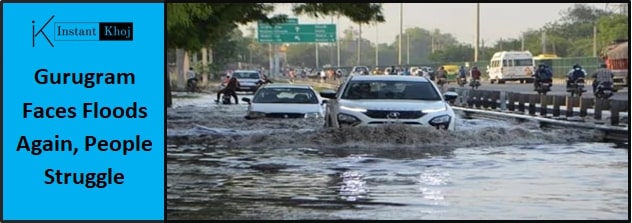Gurugram, Haryana — On September 1, 2025, Gurugram, India’s so-called “Millennium City,” faced yet another crippling episode of urban flooding following intense monsoon rainfall. Within just a few hours, major roads turned into rivers, vehicles were submerged, and the city’s infrastructure buckled under pressure. Despite its rapid urban growth and glittering high-rises, the city remains vulnerable to even moderate rainfall, raising serious questions about planning, drainage, and disaster preparedness.
Sudden Downpour Turns Roads into Rivers
Between 3 PM and 7 PM, Gurugram received over 100 mm of rain, overwhelming its fragile drainage network. As a result, key roadways like IFFCO Chowk, Rajiv Chowk, Golf Course Road, Sohna Road, and the Signature Tower underpass were completely submerged. Traffic across the city came to a standstill, with commuters stranded for hours.
Videos of flooded roads, half-submerged vehicles, and pedestrians wading through waist-deep water flooded social media. Some clips showed rainwater leaking from the ceilings of underpasses, drawing widespread public anger and ridicule. The city was quickly dubbed “Mini Venice” online — a sarcastic dig at its poor flood resilience.
Authorities Scramble, But Too Late
In response, the District Disaster Management Authority (DDMA) quickly issued work-from-home advisories for September 2, applicable to corporate offices, IT parks, and private organizations. All schools and educational institutions were instructed to conduct online classes until conditions improved.
But critics argue these actions were reactive rather than preventive. “Why is Gurugram always caught off guard every monsoon?” asked a local resident on X (formerly Twitter), echoing the sentiments of thousands.
Residential Colonies Hit Hard
It wasn’t just roads that were affected. Residential areas, especially in the newer sectors, suffered massive waterlogging. In Sector 70A, residents of BPTP Astaire Garden reported water entering basements and ground floors, damaging electrical panels and personal belongings. Many societies had to deploy emergency water pumps to flush out floodwater from basements and parking lots.
Meanwhile, rural pockets around Kadarpur, Ullawas, Sector 63, and others saw floodwaters enter homes, with villagers reporting water levels rising up to five feet. The overflow from breached check dams in the nearby Aravali Hills contributed to the deluge.
Why Does Gurugram Flood Every Year?
Despite being a modern business hub, Gurugram floods almost every monsoon. Experts and urban planners have long blamed the following:
-
Poor drainage infrastructure that cannot handle heavy rainfall.
-
Encroachment on natural water bodies and the destruction of wetlands, which once absorbed excess rainwater.
-
Unchecked urbanization, with real estate projects replacing green belts and natural slopes.
-
Silted stormwater drains and blocked outfalls due to poor maintenance.
According to a report by the India Meteorological Department and local civic bodies, over 60% of Gurugram’s stormwater drains are either defunct or choked. Many areas built on natural depressions now face routine flooding due to zero percolation capacity.
Public Anger Mounts
Citizens, urban activists, and environmentalists didn’t hold back their frustration. A viral comment read: “We don’t need Disneyland, we need drainage.” The statement was a direct jab at Gurugram’s flashy urban image vs. its poor infrastructure.
Others questioned why basic infrastructure like waterproofing underpasses, installing flood sensors, and upgrading drainage systems hadn’t been implemented even after repeated flood incidents over the last decade.
What Lies Ahead?
The India Meteorological Department (IMD) has forecasted more rainfall across Delhi-NCR over the coming days and issued an orange alert for Gurugram and nearby districts. The administration has assured that emergency teams are on standby, and civil engineers are working to restore mobility in affected zones.
However, many believe these measures are short-term fixes to a long-standing problem. Without structural overhauls, Gurugram will continue to sink every monsoon.
Final Thoughts
Gurugram’s latest flood disaster is not just about rain — it’s about urban mismanagement, ignored warnings, and systemic negligence. A city that houses corporate giants, global headquarters, and luxury high-rises must also ensure basic civic resilience.
It’s no longer acceptable to treat flooding as an act of nature. Gurugram must treat it as a man-made crisis — one that requires long-term planning, immediate policy enforcement, and strict accountability.
Until then, each spell of rain will keep turning this “Millennium City” into a cautionary tale.
Read more articles like this — Click here to explore now





One thought on “Gurugram Faces Floods Again, People Struggle”